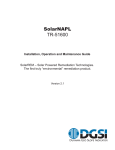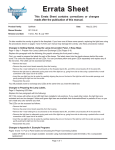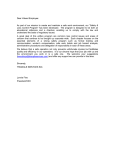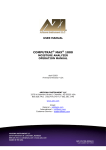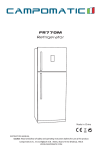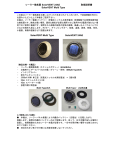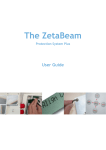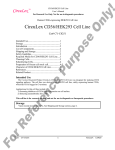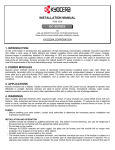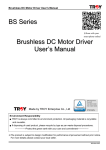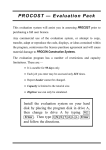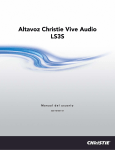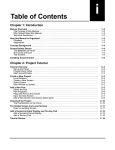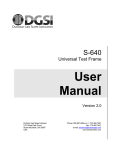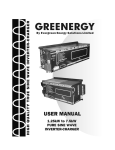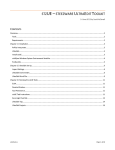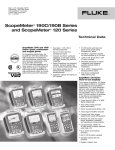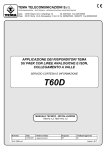Download TR-51600 - Durham Geo Enterprises
Transcript
SolarNAPL TR-51600 Operator’s Manual Version 1.2 Durham Geo Slope Indicator 2175 West Park Court Stone Mountain, GA 30087 USA Phone: 800-837-0864 or +1.770.465.7557 Fax: 770.465.7447 e-mail: [email protected] www.DurhamGeo.com Table of Contents APPLICATION, OPERATION AND MAINTENANCE GUIDE INTRODUCTION ABOUT THE SOLARREM PRODUCT FAMILY.............................................1 INSPECTION....................................................................................................1 Unit Protection ..............................................................................................2 Storage .........................................................................................................2 SPECIFICATIONS ...........................................................................................2 Performance Specifications.........................................................................2 TECHNICAL SUPPORT ..................................................................................4 Returning Merchandise for Service.............................................................4 For Resellers Only:.......................................................................................4 Trademarks ..................................................................................................4 Disclaimer .....................................................................................................4 ABOUT THE SOLARREM ...............................................................................5 TECHNICAL DESCRIPTION – OVERVIEW ..................................................5 ABOUT THE COMPONENTS .........................................................................6 EXTERNAL COMPONENTS...........................................................................6 INTERNAL COMPONENTS ............................................................................6 GENERAL SAFETY INFORMATION..............................................................8 INSTALLATION INSTRUCTIONS...................................................................9 HOW TO INSTALL OUR PRODUCTS RIGHT...THE FIRST TIME...............9 What’s the first thing I should do? ...............................................................9 Pole Installation and Mounting ....................................................................9 Electrical Wiring............................................................................................9 FREQUENTLY ASKED QUESTIONS ..........................................................10 2 1 INITIAL SET-UP OF THE SOLARNAPL.......................................................12 INTRODUCTION TO SETUP ........................................................................12 OPERATING THE SOLARREM....................................................................12 Starting Setup.............................................................................................12 The Components of the SolarREM unit are as follows: ...........................12 Setup Keys on the Optimate PLC Controller............................................14 Operation of the OptiMate PLC Controller................................................14 SYSTEM OPERATION ..................................................................................15 Start Up Screen..........................................................................................15 Air Discharge Set-Up Procedure...............................................................16 Checking System Operations....................................................................16 MAINTAINING THE SOLARREM .................................................................17 SYSTEM CHECKOUT ...................................................................................17 MAINTENANCE .............................................................................................17 Maintenance Procedures...........................................................................17 Glossary:.....................................................................................................23 3 Chapter 1 Application, Operation and Maintenance Guide Introduction SolarREM – The First Truly Environmental Remediation Product About the SolarREM Product Family SolarREM identifies the three provided for assistance in bioremediation of contaminated sites, remote from an economical power supply, not quickly accessible, and subject to long term remediation requirements. 1) The SolarDRIP provides fluid injection to the ground water table. 2) The SolarVENT provides low air flow to the ground for bioremediation of LNAPL contaminants. 3) The SolarNAPL provides pneumatic pumping capabilities for removal of LNAPL contaminants laying on the ground water table. It is provided with a storage tank level sensor to shut the system down when full to prevent a surface spill. 4) The SolarPurge provides pneumatic pumping capabilities for low flow groundwater pumping. 5) The SolarSPARGE provides higher air flow into the ground water table to promote bioremediation and volatilization of LNAPL contaminants in the groundwater. 6) The SolarSKIM provides surface oil skimming equipment for removal of LNAPL contaminants from surface waters. Inspection Upon receipt of shipment at the job site, carefully check the shipment against the bill of lading. Make sure all units have been received. Inspect the carton or crating of each unit and inspect each unit for damage. Repackage unit after verifying that all components are included. Assure that the carrier makes proper notation of any shortages or damage on all copies of the freight bill and that he completes a Carrier Inspection Report. Concealed damage not discovered during unloading must be reported to the carrier within 15 days of receipt of shipment. NOTE: It is the responsibility of the purchaser to file all necessary claims with the carrier. Notify the SolarREM Traffic Department of all damage within fifteen (15) days of shipment. Unit Protection Cover units on the job site with either shipping cartons, vinyl film, or an equivalent protective covering. Cap the open ends of pipes stored on the job site. In areas where painting, plastering, or the spraying of fireproof material has not been completed, all due precautions must be taken to avoid physical damage to the units and contamination by foreign material. Physical damage and contamination may prevent proper start-up and may result in costly equipment clean-up. Examine all pipes, fittings, and valves before installing any of the system components. Remove any dirt found on these components. Storage CAUTION Do not store or install units in corrosive environments. Corrosive conditions and high temperature or humidity can significantly reduce performance, reliability and service life. Always move units in an upright position. Tilting units on their sides, or back may cause equipment damage. Upon the arrival of equipment at the job site, immediately store solar panel units in their shipping cartons in a clean, dry area. Store units in an upright position at all times. Specifications The SolarREM units are designed to provide operating capabilities in remote locations away from the power grid, and to be operated in a simple fashion, both in setup and in operating mode. The units are designed for a no shock or explosion hazard environment. A deep cycle battery is provided to withstand the rigors of weather and deep power draw. The solar panel provides recharge of the battery to permit a longer operating period of the units. A low draw DC powered compressor pump provides the necessary compressed air for all configurations. The control center of the SolarREM units is a PLC unit and operator interface panel. This permits factory default settings, or modifications to the cycle by the onsite operator to provide a site specific cycle time for optimum product removal. Performance Specifications The Standard Base Model as supplied by SolarREM is designed to provide a sturdy low maintenance air compressor providing programmable timing to maximize the on/off cycle to the conditions of the site. The controller interface is located inside the steel box to provide access only by authorized personnel. Access to total cycles and air compressor on time information is provided to aid in reporting of equipment performance. 2 The battery and solar panel are sized to maximize operating time, providing up to 2 days operations during periods with minimal sunlight (heavy rain). The solar panel ensures quick recharge to get the battery back into operation as the result of a long low sunlight period. A 7.5 gallon ASME air receiver tank is standard to provide optimum compressor pump operation and minimize on off cycles that result in large battery draw. The table on the following page summarizes the SolarREM family of equipment and typical performance limits for standard operations. No. Application Model Type Wells Performance gpd 1 SolarDrip DB020 Basic 1 30 fluid injection DM060 Programmable 3 60 cfd 2 SolarVent BB060 Basic 1 200 pulsed air, low flow BP060 Programmable 1 200 bioventing BP120 Programmable 1 400 depth/psi 30/30 60/40 90/70 gpd 3 SolarNAPL NB020 Basic direct free product NP060 Programmable 1 recovery NP120 Programmable 1 NM060 Programmable 2 60 NM120 Programmable 4 120 1 30 22 15 60 50 40 120 100 80 50 40 100 80 gpd 4 SolarPurge PB020 Basic 1 30 22 15 low flow PP060 Programmable 1 60 50 40 groundwater PP120 Programmable 1 120 100 80 pumping PM060 Programmable 2 60 50 40 PM120 Programmable 4 120 100 80 water column/psi 10/5 20/10 30/15 cfd 5 SolarSparge SB060 Basic 1 220 160 100 pulsed air sparging SP060 Programmable 1 220 160 100 SP120 Programmable 1 440 320 200 gpd 6 SolarSkim MB020 Basic 1 30 surface oil MM060 Programmable 2 60 skimming MM120 Programmable 4 120 The performance rates indicated above assumes six hours of sunlight, the units and pumps are installed in accordance with the Manufacturer's Guidelines, and the soil environment can yield the indicated rates. 3 Technical Support Information presented in this publication has been carefully checked for reliability. However, no responsibility is assumed for inaccuracies. The information contained in this document is subject to change without notice. If a problem arises with your system, you should turn to your dealer or the manufacturer for help first. Your system has most likely been configured by them, and they should have the best idea of what hardware and software your system contains. Hence, they should be of the most assistance. Further, if you purchased your system from a dealer near to you, you can actually bring your system in to them to have it serviced, instead of attempting to do so yourself (which can have expensive consequences). Manufacturer DURHAM GEO SLOPE INDICATOR 2175 West Park Ct Stone Mountain, Ga 30087, USA Tel: +1-770-465-7557 Fax: +1-770-465-7447 Returning Merchandise for Service During the warranty period, contact your distributor or system vendor FIRST for any product problems. This warranty only covers normal customer use and does not cover damages incurred during shipping or failure due to the alteration, misuse, abuse, or improper maintenance of products. For Resellers Only: A receipt or copy of your invoice marked with the date of purchase is required before any warranty service can be rendered. You can obtain service by calling the manufacturer for a Return Merchandise Authorization (RMA) number. The RMA number should be prominently displayed on the outside of the shipping carton and the package should be mailed prepaid, or hand-carried to the manufacturer. SolarREM will pay to have the unit shipped back to you. Trademarks SolarREM is a trademark of the SolarREM Corporation. All other trademarks are the property of their respective companies. Disclaimer Information presented in this publication has been carefully checked for reliability. However, no responsibility is assumed for inaccuracies. The information contained in this document is subject to change without notice. 4 Chapter 2 About the SolarREM The SolarREM is a solar powered remediation unit capable of either free product recovery system (SolarNAPL, SolarPURGE, SolarSKIM), fluid injection (SolarDRIP) or pressurized air (SolarVent, SolarSPARGE). The unit is capable of running up to 2 days without sunlight. By relying on solar power, SolarNAPL can be installed in any location where a power supply necessary to run traditional pumping systems is not economically available. SolarNAPL is a self-contained remediation system consisting of a solar panel, battery, air compressor and pump and associated wiring and controls. The solar panel charges the battery, which serves as the power supply for the air compressor and the system controls. When activated, the compressed air is discharged to the pneumatic pump, forcing the product up the pump discharge hose and into a holding tank. The operating characteristics and performance of the SolarNAPL is determined in part by the specifications of the solar panel, battery and pump. Operating parameters such as the cycle time is by a programmable logic controller (PLC). The PLC is also programmed to record system performance data. To operate correctly and efficiently, air must be pumped into the pneumatic pump at a pressure sufficient to displace the water column and overcome frictional losses in the system. The injected air displaces the product collected in the pump and discharges it to the collection system. This air and product cycling continues in the pump while the air is available. Technical Description – Overview The power supply for SolarNAPL consists of a photo-voltaic array and battery. The photovoltaic cells use sunlight to charge the battery. The battery in turn powers the system controls and, the air compressor pump. The pump fills an air receiver tank that provides the pressure and volume of air required to displace the product in the pneumatic pump. A voltage regulator is used to prevent the battery from overcharging. The voltage regulator also prevents draining of the battery when there is not enough sunlight (e.g., at night) to sustain flow of electricity from the solar panel to the battery. The SolarNAPL is operated by a programmable logic controller (PLC). After an on-site pilot test to determine optimum operating conditions including injection pressure and air flow rate, the PLC is programmed through the controller interface for on and off cycles. When the system is activated, the compressor pump pressurizes the air receiver tank. When the pressure inside the tank drops below the lower set value, the pump turns on to re-pressurize the tank until the air pressure reaches the high set value. At the set intervals, the solenoid valve opens and allows the flow of air to the pneumatic pump. 5 Chapter 3 About the Components External Components 1) Solar Panel: The solar panel is capable of producing a minimum of 16 to 20 amphours per day at 75 percent sunlight for a minimum of six hours.. A minimum configuration is a 60 Watt panel, with larger panels used as necessary for particular sites or applications. 2) Battery: The battery supplies 12-volt DC power to the unit. It is capable of providing back up power for up to two days for a typical SolarREM installation. The battery is an industrial 12-volt deep cycle battery designed for use with solar panels. The minimum size provides 120 amp-hours. The battery is an absorbed glass mat (AGM) construction . We do not recommend use of typical lead acid batteries. 3) Weatherproof Enclosure: The weatherproof enclosure is designed to house and protect all equipment except the solar panel and the air receiver tank. The enclosure provides weather protection as well as vandalism protection of less durable equipment. The weatherproof enclosure is enamel-coated steel for long wear. Dimensions are 20 inches high by 16 inches wide by 6 inches deep, with a front opening, locking panel. 4) Air Receiver Tank: The air receiver tank equalizes air flow and eliminates pulsing of flow from the air compressor to the well point. The air receiver tank is a 7.5 gallon tank meeting the ASME regulations. 5) Mounting Track and Mounting Rail: The SolarSPARGE system, including the solar panel, weatherproof enclosure and air receiver tank are mounted on Schedule 40 galvanized steel piping, or Unistrut assemblies. Internal Components 1) Photovoltaic Charge Controller: Also known as a charge regulator, this part of the system provides safe charging of the battery by the solar panel, and regulates the charge flow to maximize the operating life of the battery. The charge regulator also prevents discharge of the battery back through the solar panel during periods of no sunlight. The charge regulator shall be a Prostar 30, manufactured by Morningstar Corporation, equipped with a link to a computer through an RS232 port. 6 2) Control Panel and Programmable Logic Controller (PLC): The control panel and PLC control and automate the various functions of each piece of equipment. The PLC includes ports for computer or telephone connections to monitor system operation and performance. The control panel shall be manufactured with the DL105 PLC made by Direct Logic. The unit shall include 10 inputs and 8 outputs for system monitoring and response. 3) Solenoid Valve: The solenoid valve is the open/close control point for air supply to the well point. The solenoid valve is controlled by the PLC and is placed in line after the air receiver tank. The solenoid valve shall be an ASCO Red Hat two-way solenoid valve. 4) Pressure Switches: The high pressure switch shall have a range of 80-100 psi and be equipped with a dual manual lever (Automatic-Off). The low pressure unit shall have a range of 0 to 40 psi and operate on an automatic setting. The pressure switches shall be supplied by Pumptrol, Grainger, or the equivalent. 5) Air Compressor Pump: The air compressor shall be one of two options, depending on site conditions or user specifications. A Gast oil-free rocking piston pump (Model 75R645) is capable of producing a maximum pressure of 30 psi at 4.9 cfm open flow. The alternative, a Gast twin cylinder pump (Model 6L) can produce a maximum pressure of 50 psi at 6.2 cfm, and can be used where either higher pressure or air flow or both are required. 6) Piping: All internal piping shall be high-pressure flexible hosing with Schedule 40 galvanized steel pipe external fittings and external screw threads. All fittings shall be clamped or coated with Teflon tape to minimize air loss. 7 Chapter 4 General Safety Information The SolarREM Equipment is designed to be safe when handled correctly. It is important that all site safety procedures be followed, including all Occupational Heath and Safety Administration (OSHA) site requirements. Whenever working around any electrical equipment, care must be taken to avoid shock or worse injury. The solar panel cells are encapsulated between a tempered glass cover and an EVA pottant, with PVF back sheet to provide maximum protection from the most severe environmental conditions. The entire laminate is installed in an anodized aluminum frame to provide structural strength and ease of installation. 8 Chapter 5 Installation Instructions How to install our products right...the first time. What’s the first thing I should do? The first thing you should do is read this user’s manual. It contains important information which will make configuration and setup much easier. Pole Installation and Mounting The next step is to properly attach the SolarREM unit and equipment to a secure mounting pole. We recommend a three inch Schedule 40 steel pole mounted a minimum of four feet into the ground with a concrete base of a least one foot around. The pole should extend about seven feet high to allow for clearance of the solar panel from the box. Electrical Wiring Once the SolarREM unit, solar panel(s) and battery have been installed as per the installation configuration, all components must be electrically connected, and grounded. WARNING! To avoid possible injury or death due to electrical shock, carefully examine the wiring, and connect to the appropriate battery and solar panel lead. The solar controller will prevent cross connections from damaging the solarREM unit. CAUTION! Use only copper conductors for field installed electrical wiring. All field installed wiring, including electrical ground, must comply with the National Electrical Code (NEC) as well as all applicable local codes. In addition, all field wiring must conform to Class II temperature limitations described in the NEC. Consult the unit wiring diagram located on the inside of the compressor access panel to ensure proper electrical hookup. Once the solarREM unit is mounted on the platform provided by you, remove the four 10 Gauge wires from the packaging on the back of the control panel box. The wires are labeled for the Battery and for the Solar Panel. Green is for positive, and Black is for the negative. Connect each of the wires to the appropriate terminals on the battery and solar panel, ensuring a tight connection is made. 9 Once this is completed, open the control box, front panel and familiarize yourself with each of the components. Your will note that power should now be on at the Solar Controller, PLC and Controller Panel. Once the SolarREM unit is mounted and electrically connected, check that the solar controller is signaling a battery charge, and the solar panel is charging the battery. If all lights are operating, you are ready for the initial setup of the operating parameters. Refer to the next section for details on running the SolarREM unit. Frequently Asked Questions Q: Why don’t I get a display after I connect the wiring. A: Check for cross connections with the wiring. If you have inadvertently connected either the battery or the solar panel to the wrong leads, you will not get a signal on the solar controller. If the wiring is crossed, the same will apply, you will not get a signal. Q: Why don’t I get an indication the solar panel is charging the battery? A: First check the solar panel is connected to the solar controller, and with the correct polarity. Second, check the solar panel is pointed at the correct angle and location to receive the maximum sunlight during the day. Q: What is a solar cell. A: A solar cell is a kind of semiconductor device that takes advantage of the photo-voltaic effect, in which electricity is produced when the semiconductor's PN junction is irradiated. When light strikes a solar cell, part of it is reflected, part of it is absorbed, and part of it passes through the cell. The absorbed light excites the bound electrons into a higher energy state, making them free electrons. These free electrons move about in all directions within the crystal, leaving holes where the electrons used to be, and the holes also shift around the crystal. The electrons (-) collect in the N-layer, the holes (+) in the Player. When the outside circuit is closed, electricity flows. Q: What about grounding of the SolarREM unit 10 A: The SolarREM unit is to be grounded to the mounting pole with the provided ground wire. 11 Chapter 6 Initial Set-up of the SolarNAPL Introduction to Setup This manual describes the SolarREM Setup program. The setup program lets you modify the basic system configuration settings. The settings are then stored in a dedicated battery-backed memory, called CMOS RAM, that retains the information when the power is turned off. The processor in your SolarREM unit is a customized version of an industry-standard programmable logic controller (PLC). The PLC provides critical low-level support for the system central processing, memory, and I/O subsystems. The PLC has been customized by adding important, but nonstandard, features such as password protection, power management, and detailed fine-tuning of the chipset controlling the system. The rest of this manual is intended to guide you through the process of configuring your system using the controller interface. Operating the SolarREM Starting Setup The Components of the SolarREM unit are as follows: 1) Solar Controller: Controls and monitors recharge of the battery, as well as the on/off power supply to the unit. 2) PLC: Provides the functionality of the unit to allow operations to site conditions. 3) PLC Controller: Provides the operator interface to change the operating parameters, as well as determine the system operating duration. 4) Regulator and Pressure Gauge: Provides the regulation point for system discharge pressure, and can be adjusted to suit site specific requirements. 12 Once the SolarREM unit is installed and connected to the solar panel and battery, power will be on through the system. The SolarREM PLC is immediately activated when you first connect the battery power. The PLC starts a countdown to system activation based on the default settings in the EPROM. The system automatically starts at the end of a five minute countdown, or alternatively by pressing the F1 or START button. You will note on the ProStar 20 Photovoltaic (Solar) Controller, that a green light will be on indicating the battery type as SEALED. Your are shipped with a Solar Extender Advanced Glass Matte (AGM) type battery. This is a sealed type battery, and is the recommended battery for this unit. However, for optimum operation of this battery, select as a flooded battery. Follow the instructions on the Solar Controller to change the battery type (touch battery negative to terminal on solar controller with connecting wire to turn light off). Ensure the air receiver tank bottom drain plug is fully closed (clockwise). Pull down on the air regulator knob to engage it. Then turn the regulator counter-clockwise to remove all discharge line pressure. Depress the red selector switch on the pressure sensor (Pumptrol) down, or towards the pump, to the automatic position. You are now ready to set up the system operation. 13 Setup Keys on the Optimate PLC Controller The table below, shows how to navigate in Setup using the keyboard. Key Function F1 System Start F2 System Stop F3 High Level Reset (For Internal Operations as Reset by External Stop) F4 Reset to Default Factory Settings F5 Reset Counters to “0” Menu To Enter Menu Selection Up Up Arrow to scroll through list, or increase value Down Down Arrow to scroll through list, or decrease value Clear/Abort To Return to previous screen Enter To change value and accept new set point Operation of the OptiMate PLC Controller Turn off the EXTERNAL red STOP button (depress). Then disconnect the power by pressing the red power DISCONNECT button on the Solar Controller. A red light will flash on the power button and the power will be disconnected. Push the DISCONNECT button a second time to reconnect the power to the SolarREM. You will note the lights on the solar controller cycle through and stop on the BATTERY CHARGE condition. Power is then restored to the solarREM unit and you will note lights on the PLC. The OptiMate operator control panel will display “Optimate Series Model 620 Terminal”, and then display: SolarREM Menu:Setup F1:Start If this does not happen, cycle the DISCONNECT power button off and on again. Alternatively, ensure the HIGH LEVEL FLOAT alarm is not signaling. You are unable to change any settings until the high level alarm has been disabled, by emptying the collected product from the storage tank. Turn off the EXTERNAL red STOP button (depress). Once the float is returned to the normally closed position, with the STOP button depressed, this will clear the float High Level setting, if it has been activated. Select Menu, at which point, the display will show the following: Air Cycle “ON” Time Enter/Arrow/Clear If you select ENTER, you will cycle to the display for setting the Well “ON” time, with the default set to 120.0 seconds, (2.0 minutes), or previous settings if they have been changed. Using the up and down arrows on the upper key pad level, change the ON time 14 to any value between 0 and 480.0 or 0 and 480.0 seconds, as each unit is 1/10 of one second (0.1 second). Maintain the pressure on the key pad to increase the rate of change of your setting. When you have selected the appropriate “ON” time, press the ENTER button to accept the selected time. The display will return to the previous screen. You can push ENTER again to return to the screen. Your selected value will now be shown as the ON time. Depress the CLEAR/ABORT key to return to the Main Menu. When you select the MENU key, use the down and up arrow keys to cycle through the following settings: Selection Identification Air Cycle “ON” Time Air Discharge Time Air Cycle “OFF” Time Air Off Time Between Cycles Air Run (Reset) Compressor Running Time (minutes) Can Be Reset Air Run (No-Reset) Compressor Running Time (minutes) Cumulative History Air On Cycles Air On Cycles to the Product Pump Since Last Reset When you select one of the options by pressing the ENTER button, you are provided with the option of adjusting the Time, or displayed information. To reset the compressor run time, as well as the number of compressor cycles both to “0”, depress the F5 button. To return to the previous screen, you must depress the CLEAR/ABORT button. This must be done to return to the initial startup screen. Once you have recorded and accepted the operating times and any resets, you can then start the unit operating. For initial setup and installation confirmation purposes, you may want to set the air ON time to 600 (60.0 sec), and the OFF time to the setting of 600 (60 sec or 1 min). This will provide a quicker cycle time to monitor the effectiveness of the equipment and establish suitable cycle times. System Operation Start Up Screen When the SolarREM unit is first activated, it goes into a 2.5 minute countdown before starting. This allows you to change the settings, or to start the system immediately based on the stored settings. Depress the F1 Start button. The compressor pump will start, as will the first rest cycle before discharge of air to the product pump. This will allow charging of the air receiver tank as it may have no air. The PLC Controller Panel will display the following initial screen: SolarREM: STARTING Press F2 to Stop 15 Once the SolarREM has cycled through the operation for the first time, it will change to the following screen: SolarREM: STARTING Press F2 to Stop The compressor will turn off at the factory set high pressure range of between 70 and 80 psi. As air is consumed in the pneumatic pump operation, or sparging operation, the pressure in the air receiver tank falls. At a pressure point between 65 and 70 psi, the low pressure sensor connected to the compressor pump is activated, tripping the relay to the compressor pump. The pump is then started and refills the receiver tank. The run time of the compressor pump is stored in the PLC and can be monitored from the PLC Controller. Air Discharge Set-Up Procedure The operational effectiveness of the pneumatic discharge pump is dependant upon air volume and pressure. Initially, you have closed off flow to the pump by turning the pressure regulator valve counter-clockwise. After about 4 minutes of the compressor pump operation, the air receiver tank should be at about 40 psi. At this time, slowly turn the pressure regulator valve clockwise. As you turn the valve, you will note the pressure gauge rise. This is the discharge pressure that is selected based on the site parameters including amount of product to remove, and depth of well. Typical operating pressures are between 40 and 70 psi. Air Solenoid valve will not operate below 26 psi Checking System Operations Any time that you want to review air receiver tank pressures, or adjust the pressure regulator, turn off the operation. Depress the STOP button on the outside of the unit, and then depress the F2 key on the PLC Controller to disable the operation. Any changes to be made to the SolarREM units require that the operating cycle be stopped by pressing the F2 key on the PLC Controller. When the F2 key is depressed, you return to the Main Menu screen and the operation is halted. You can then show the system operations, and adjust any of the Menu parameters. In case of an automatic start of the system, you must cycle the POWER button on and off to reset the OP620 menu features. Checking of the air receiver tank internal pressure can be completed by fully closing the air pressure regulator valve (turning clockwise). Always make sure that you back off the discharge pressure before restarting the SolarREM unit. Once you have completed any changes to the system, or changed air discharge rates, make sure you CLEAR/ABORT back to the main menu, then press F1 to restart the system. 16 Chapter 7 Maintaining the SolarREM SYSTEM CHECKOUT When the installation is complete and the system is cleaned and flushed, follow the system Checkout procedure outlined below. 1) Voltage: Ensure that voltage is within the utilization range specifications of the unit compressor and fan motor. 2) Wiring: Ensure that fuses, breakers, and wire are sized correctly and that low voltage wiring is complete. 3) System Cleaning: Properly clean the SolarREM unit periodically, especially the solar panel to ensure optimum sunlight penetration. 4) Compressor: Ensure that compressor mounting bolts are tightened to reduce vibration noise. 5) System Controls: To ensure that no catastrophic system failures occur, verify that system controls are functioning and that the sequencing is correct. 6) Cabinet: Ensure that all cabinet panels are properly in place. 7) Miscellaneous: Note any questionable aspects of the installation. MAINTENANCE Maintenance Procedures Perform the maintenance procedures outlined below periodically as indicated. 1) UNIT INSPECTION: Visually inspect the unit annually. Pay special attention to hose assemblies. Repair any leaks and replace deteriorated hoses immediately. 2) COMPRESSOR PUMP MOTOR: All units are oil less motors. DO NOT lubricate. Conduct amperage checks annually. Amperage draw should not exceed normal full load or rated load amps by more than 10% of the values noted on the unit nameplate. Maintain a log of amperage values to detect deterioration prior to component failure. 17 3) AIR RECEIVER TANK: Periodically open the drain at the base of the tank to drain any accumulated water condensation. 4) SOLAR PANEL: Frequently clean the glass cover to remove dirt accumulations. Ensure the unit is mounted in the correct alignment for maximum sun exposure. 5) WIRING: Ensure all wiring and connectors are secure. Refer to the wiring diagram for correct connection point. 6) BATTERY: The battery should be boost-charged every ninety days when in storage, or if its open circuit voltage falls below 12.5 volts for a 12 volt. Boost charge batteries using a regulated constant potential charger, such that the output is 14.1 to 14.4 volts (for 12 volt batteries). The battery will be fully charged when the current drops to approximately 0.5 amperes for one hour. 7) PROSTAR METER: Refer to the Manufacturer’s information for maintenance and testing requirements of this unit. 18 Appendix A Replacement Parts Item No. 1 2 3 4 5 6 7 8 9 10 11 12 13 14 15 16 17 18 19 20 21 22 23 24 25 26 27 28 29 30 31 32 33 34 35 36 37 38 39 40 41 Description 20" x 16" x 6" NEMA Type 3R Metal Enclosure 7.5 Gal. Stationary ASME Code Air Tank 110 Watt Solar Panel Kyocera KC60 3.55 Amps @ 16.9 12 Volt AGM Battery 105AH Battery Box Plastic Enclosure Interior White Panel 20 Amp Solar Controller PLC Controller PLC Operator Interface PLC and Interface Cable Motor Latching Relay Motor Latching Relay Base 1/10 HP Air Compressor Vibration Isolators for Motor Compact Cylindrical Pressure Switch NEMA 4 "Piggyback" Filter/Regulator with Gauge 1/4" Normally Non-Passing Solenoid Valve 30 mm Connector for ARO 1/4" Valve 1/4" - 3 Way Hose Manifold Emergency Stop Button 2-Pin Receptacle for High Level Float - Female 2-Pin Plug for High Level Float with Cable - Male Liquid Level Switch 1/2" x 1 1/2" Nipple 1/2" x 90 Elbow 1/2" x 1/4" Bushing Reducer 1/4" x 5" Nipple 1/4" Tee 1/4" ASME Air Safety Valve 1/4" (M) NPT x Barb 1/4" (M) NPT Elbow Barb 1/4" Male x 1/4" Female 90 Street Elbow 1/4" Male x 1/8" Female Bushing 1/4" Female x 1/8" Male Adapter 1/4" x Close Nipple 1/4" SS Screw Clamps 1/4" Hex Lock Nut 1/4" Hex Socket Plugs Universal Pneumatic Quick Coupler Female 2" Unistrut Brackets Solar Panel Mounting Brackets 19 Req'd Vendor Number 1 1 1 1 1 1 1 1 1 1 1 1 1 3 1 1 1 1 1 1 1 1 1 1 1 1 1 2 1 2 2 2 1 1 2 4 1 2 1 2 2 6C718 2Z623 PVX-12105 2W827 PSR 20MC F1-130DR-D OP-620 OP-2CBL 6C873 2A582 5Z349 3CC01 46995K4 5Z415 4HN46 4HN55 4HK96 E22JLB2N8B 6897K84 6897K81 2A551 1A111 1A112 3P869 1A112 3P886 5A708 6X409 4A492 3P882 3P869 3P889 3P874 1A527 5P977 3P878 6CX02 2A111 2A112 High Power The KC60 has 36 high efficiency (14%) multicrystal cells and is suited for any application in any environment. HIGHLIGHTS OF KYOCERA PHOTOVOLTAIC MODULES Kyocera's advanced cell processing technology and automated production facilities have produced a highly efficient multicrystal photovoltaic modules. The conversion efficiency of the Kyocera solar cell is over 14%. These cells are encapsulated between a tempered glass cover and an EVA pottant with PVF back sheet to provide maximum protection from the severest environmental conditions. The entire laminate is installed in an anodized aluminum frame to provide structural strength and ease of installation Electrical Specifications MODEL KC60 Maximum Power 60 Watts Maximum Power Voltage 16.9 Volts Maximum Power Current 3.55 Amps Open Circuit Voltage 21.5 Volts Short-Circuit Current 3.73 Amps Length 751 mm (29.6 in.) Width 652mm (25.7in.) Depth 52mm (2.0 in.) Weight 7.8kg (17.2 1bs.) Note: The electrical specifications are under test conditions of Irradiance of tkW/m2 Spectrum of 1.5 air mass and cell temperature at 25~C • • • • Kyocera reserves the right to modify these specifications without notice QUALITY ASSURANCE Kyocera multicrystal photovoltaic modules exceed government specifications for the following tests Thermal cycling test Thermal shock test Mechanical, wind and twist loading test Salt mist test Light and water-exposure test Field exposure test Electrical isolation test Hail impact test 20 The map below shows the yearly average for an average December (worst case) day As you can see, in the winter it's an entirely different story. Much of the country now gets an average of 4 hours or less of full sun hours per day. 21 This map shows the yearly average, in kilowatt-hours per square meter for an average yearly day. Translation: At high noon on a clear day, each square meter receives 1000 watts of sun power. If you look at the large yellow areas, you will see that it gets around 6,000 watts on an average day. So, even though the average day is exactly 12 hours, the power you actually get on your panels is equal to about 5 to 6 hours of full sun per day. Since the typical modern solar panel is about 12% efficient, you will get about 700 watts per square meter of panel. So, if the map says that you live in a "six" area, you can expect sun power equal to 6 hours per day over the entire year. Next map. 22 Glossary: Active Material- electrode material which produces electricity during its chemical conversion. Ampere- Unit of electrical current. Ampere-hour (Ah)- The capacity of a storage battery is measured in ampere-hours. One ampere hour is defined as a current flow of one ampere for a period of one hour. Five ampere-hours means a current flow of one ampere for five hours, a current flow of 2 1/2 ampere for 2 hours, or any multiple of current and time that will result in five. This relationship can be expressed as follows: Capacity (In ampere hours)= I*T. Where I is the current (in amperes) and T is the time (in hours). The capacity of a storage battery is usually based on a given discharge rate, since the capacity will vary with the rate of discharge. The capacity of an aircraft battery is usually based on a one hour discharge rate. A 17 ampere hour battery will supply a current of approximately 17 amperes for a period of one hour. A 34 ampere battery will deliver twice that amount of current over the same period of time. If a very heavy load is applied to the battery, it may become discharged in a few minutes. Battery- A combination of two or more chemical cells electronically connected together to produce electric energy.(Common usage permits this designation to be applied also to a single cell used independently.) Boost Charge- A charge applied to a battery which is already near a state of full charge, usually of short duration. C rate- Discharge or current rate in amperes; numerically equal to rated capacity of a cell in ampere-hours. Capacity- The quantity of electricity delivered by a battery under specified conditions, usually expressed in ampere-hours. Capacity, rated- See nominal capacity. Cell- An electrochemical device composed of positive and negative plates, separator, and electrolyte which is capable of storing electrical energy. Cell reversal- Reversing of polarity within a cell in a multi-cell battery due to over discharge. Charge- The conversion of electrical energy from an external source, into chemical energy within a cell or battery. Charge Rate- The rate at which current is applied to a secondary cell or battery to restore its capacity. Charge retention- The tendency of a charged cell or battery to resist self-discharge. Concavo-concave- RG batteries have one-way cell vent valves designed to relieve excess positive internal pressure. Occasionally, when the atmospheric pressure is greater than the internal pressure of the battery, caused by rapid decrease in altitude, the battery case may become temporarily concave. Constant Potential (CP) charge- Charging technique where the output voltage of the charge source is held constant and the current is limited only by the resistance of the battery. Constant Current (CI) charge- Charging technique where the output current of the charge source is held constant. Counter EMF- Voltage or a cell or battery opposing the voltage of the charging source. Current- The rate of flow of electricity. The movement of electrons along a conductor. It is comparable to the flow of a stream of water. The unit of measurement is an ampere. Cut off voltage- Battery voltage reached at the termination of a discharge. Also known as end point voltage or EPV. Deep discharge- Withdrawal of 50% or more of the rated capacity of a cell or battery. 23 Depth of discharge- The portion of the nominal capacity from a cell or battery taken out during each discharge cycle, expressed in percent. Shallow depth of discharge is considered as 10% or less, deep depth of discharge is considered 50% or more. Discharge- The conversion of the chemical energy of a cell or battery into electrical energy and withdrawal of the electrical energy into a load. Discharge rate- The rate of current flow from a cell or battery. Distilled Water- Water which has been freed of minerals by a process or vaporization and subsequent condensation. Dry charge- Process by which the electrodes are formed and assembled in a charged state. The cell or battery is activated when the electrolyte is added. Effective internal resistance Re- The apparent opposition to current within a battery that manifests itself as a drop in battery voltage proportional to the discharge current. Its value is dependent upon battery design, state-of-charge, temperature, and age. Electrolyte- In a lead-acid battery, the electrolyte is sulfuric acid diluted with water. It is a conductor and is also a supplier of hydrogen and sulfate ions for the reaction. Electromotive Force (EMF)- Potential causing electricity to flow in a closed circuit. Electron- That part of an atom having a negative charge. End-of-discharge voltage- The voltage of the battery at the termination of a discharge but before the discharge is stopped. See Cut off voltage. End-of-life- The stage at which the battery or cell meet specific failure criteria. End-point voltage- Cell or battery voltage at which point the rated discharge capacity had been delivered at a specified rate-of-discharge. Also used to specify the cell or battery voltage below which the connected equipment will not operate or below which operation is not recommended. Sometimes called cutoff voltage or voltage end point. Entrainment- The process whereby gases generated in the cell carry electrolyte through the vent cap. Fast charging- Rapid return of energy to a battery at the C rate or more. Float charge- A method of maintaining a cell or battery in a charged condition by continuous, long-term, constant voltage charging at level sufficient to balance selfdischarge. Flooded cell- A cell design which incorporates an excess amount of electrolyte, also see Vented Cell. Gassing- The evolution of gas from one or more of the electrodes in a cell. Gassing commonly results from local action (self discharge) or from the electrolysis of water in the electrolyte during charging. Ground- In aircraft use, the result of attaching one battery cable to the body or airframe which is used as a path for completing a circuit in lieu of a direct wire from a component. Hydrometer- A float type instrument used to determine the state-of-charge of a battery by measuring the specific gravity of the electrolyte (i.e. the amount of sulfuric acid in the electrolyte). Internal impedance- The opposition to the flow of an alternating current at a particular frequency in a cell or battery at a specified state-of-charge and temperature. Internal Resistance- The opposition or resistance to the flow of a direct electric current within a cell or battery; the sum of the ionic and electronic resistance of the cell components. Its value may vary with the current, state-of-charge, temperature, and age. With an extremely heavy load, such as an engine starter, the cell voltage may drop to approximately 1.6. This voltage drop is due to the internal resistance of the cell. A cell that is partly discharged has a higher internal resistance than a fully charged cell, hence it will have a greater voltage drop under the same load. This internal resistance is due to the accumulation of lead sulfate on the plates. The lead sulfate reduces the amount of active material exposed to the electrolyte, hence it deters the chemical action and interferes with the current flow. Ion- Part of a molecule or group of atoms, positively or negatively charged, which transports electricity through the electrolyte. Joules- Unit of energy, equal to a watt/second (newton/meter). 24 Lead-acid- Terms used in conjunction with a cell or battery that utilizes lead and lead peroxide as the active plate materials in a diluted electrolyte solution of sulfuric acid and water. Nominal cell voltage about 2.1 volts. Lead dioxide- A higher oxide of lead present in charged positive plates and frequently referred to as lead peroxide. Lead sulfate- A lead salt formed by the action of sulfuric acid on lead oxide during paste mixing and formation. It is also formed electrochemically when a battery is discharged. Load tester- An instrument which measures the battery voltage with an electrical load on the battery to determine its overall condition and its ability to perform under engine starting conditions or essential power requirements. Nominal capacity- A designation by the battery manufacturer which helps identify a particular cell model and also provides an approximation of capacity; usually expressed in ampere-hours at a given discharge current. Nominal voltage- Voltage of a fully charged cell or battery when delivering rated capacity at a specified discharge rate. Open-circuit voltage- The voltage of a battery when it is not delivering or receiving power. Overcharge- The forcing of current through a cell after all the active material has been converted to the charged state. In other words, charging continued after 100% state-ofcharge is achieved. The result will be the decomposition of water in the electrolyte into hydrogen and oxygen gas. Oxygen recombination- The process by which oxygen generated at the positive plate during charge reacts with the pure lead material of the negative plate and in the presence of sulfuric acid and reforms water. Parallel connection- A circuit in which battery poles of like polarity are connected to a common conductor. Polarity- The electrical term used to denote the voltage relationship to a reference potential (+-). Power- Rate at which energy is released or consumed (expressed in watts). Rated Capacity- The number of Ahs a battery can deliver under specific conditions (rate of discharge, end voltage, temperature). Recombination- State in which the hydrogen and oxygen gases normally formed within the battery cell during charging are recombined to form water. Re-sealable- In a cell, pertains to a safety vent valve which is capable of closing after each pressure release, in contrast to the non-resealable vent cap. Sealed cell- Cells that are free from routine maintenance and can be operated without regard to position. Self discharge- The decrease in the state-of-charge of a cell or a battery, over a period of time, due to the internal electro-chemical losses. Separator- A porous, insulating material placed between plates of opposite polarities to prevent internal short circuits. Specific Gravity (S.G.)- The weight of the electrolyte is compared to the weight of an equal volume of pure water, used to measure the strength or percentage of sulfuric acid in the electrolyte. Starved cell- A cell containing little or no free fluid electrolyte solution; this enables gases to reach electrode surfaces readily, and permits relative high rates of recombination. State-of-charge (SOC)- The available ampere-hours in a battery at any given time. Stateof-charge is determined by the amount of sulfuric acid remaining in the electrolyte (S.G.) at the time of testing or by the stabilized open-circuit voltage. Sulfation- In its common usage, the term refers to the formation of lead sulfate of such physical properties that it is extremely difficult, if not impossible, to reconvert it to active material. Swelling- RG Battery cases swell or bulge when the cell vent valves maintain an internal pressure that is greater than the outer (atmospheric) pressure. Trickle charge- A continuous, low rate charge, the rate being just about sufficient to compensate for self-discharge losses. 25 Vent valve- A normally sealed mechanism which allows the controlled escape of gases from within a cell. Vent cap- The plug on top of a cell. It can be removed to allow for electrolyte level adjustments. Venting- A release of gas either controlled (through a vent) or accidental. Volt- Unit of electromotive force, voltage or potential. The volt is the voltage between two points of a conductor carrying a constant current of one ampere, when the power dissipated between these points is one watt. 26





























